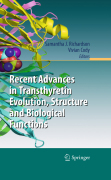
Recent advances in transthyretin evolution, structure and biological functions
Richardson, S.J.
Cody, V.
Transthyretin is a protein found in human blood and cerebrospinal fluid. It is directly involved in the transport of thyroid hormones, and indirectly in that of retinol. These hormones are essential for normal growth and development,particularly that of the brain. Spontaneous and inherited diseases affecting transthyretin result in amyloidosis. More than 80 point mutations in transthyretin lead to a variety of illnesses. Liver transplants are the most common treatment, although much research is also being carried out in drug therapies. The evolution of transthyretin has been extensively investigated – from humans to bacteria, invertebrate animals and plants. The structure of the protein has not changed, but its function has changed significantly. This is a most exciting example for the study of the evolution of protein structure-function relationships. This monograph will bring the reader up to date on the latest developments and discoveries. Transthyretin is a most exciting example for the study of the evolution of protein structure-function relationships Covers both the basic and the clinical research into transthyretin Brings the reader up to dateon the latest developments and discoveries INDICE: From the contents Mechanisms of Molecular Recognition: Structural Characteristics of Transthyretin Ligand Interactions.- TTR Synthesis During Development and Evolution: what the Marsupials Revealed.- Evolution of Transthyretin Gene Structure.- Evolutionary Insights from Fish Transthyretin.- The Salmonella sp. TLP: a Periplasmic 5-hydroxyisourate Hydrolase.- Vertebrate HIU Hydrolase - Identification, Function, Structure and Evolutionary Relationship with Transthyretin.- Transthyretin-related and transthyretin-like proteins.- The Transthyretin-Retinol-Binding Protein Complex.- TTR and RBP: Implications in Fish Physiology.- TTR and Endocrine Disruptors.- Clinical Implications of TTR Amyloidosis.- Molecular Pathogenesis Associated with Familial Amyloidotic Polyneuropathy.- Histidine 31: The Achilles’ heel of Human Transthyretin. Microheterogeneity is not Enough to Understand the Molecular Causes of Amyloidogenicity.- New Therapeutic Approaches for Familial Amyloidotic Polyneuropathy (FAP).
- ISBN: 978-3-642-00645-6
- Editorial: Springer
- Encuadernacion: Cartoné
- Páginas: 375
- Fecha Publicación: 01/07/2009
- Nº Volúmenes: 1
- Idioma: Inglés
